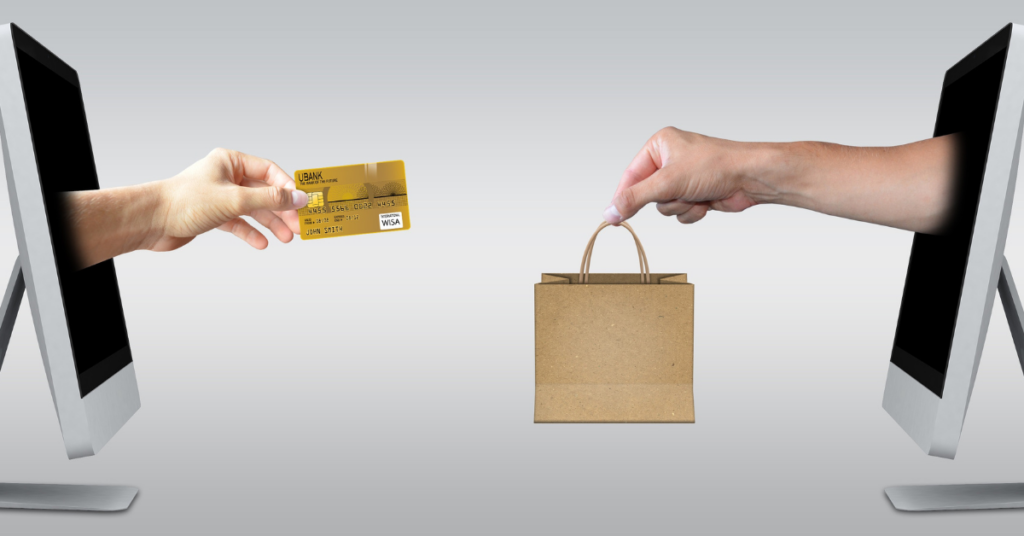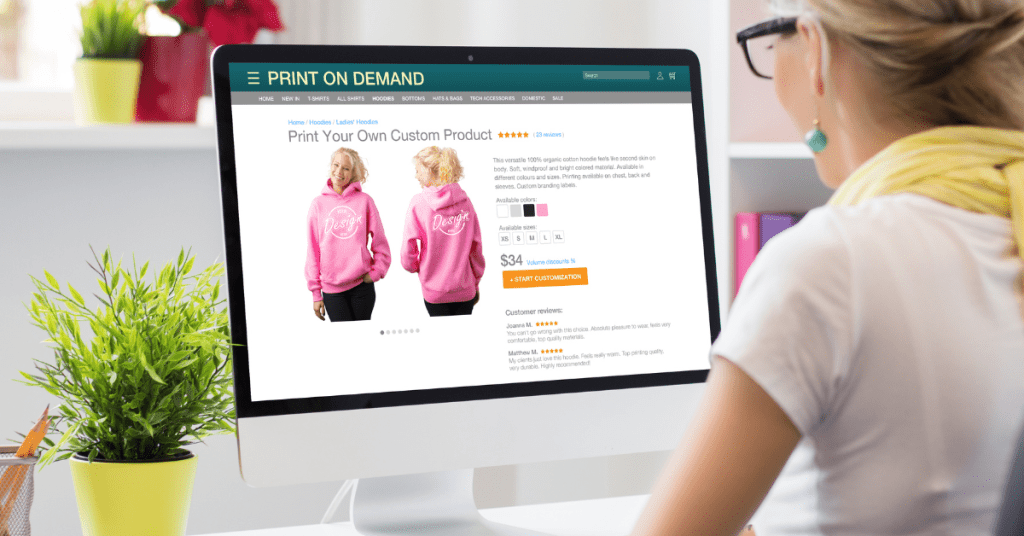In 2024, custom t-shirts have evolved beyond mere expressions of personal style. They stand as one of the top-selling print-on-demand products, boasting a market size valued at $4.31 billion. To tap into this lucrative market, consider launching your print-on-demand t-shirt store on Shopify—a beginner-friendly and easy-to-use ecommerce platform tailored for those venturing into online t-shirt sales.
This post serves as your comprehensive step-by-step guide on successfully selling t-shirts on Shopify, guiding you from the outset to set your business on the path to success.
How to sell T-Shirt on Shopify in 7 steps
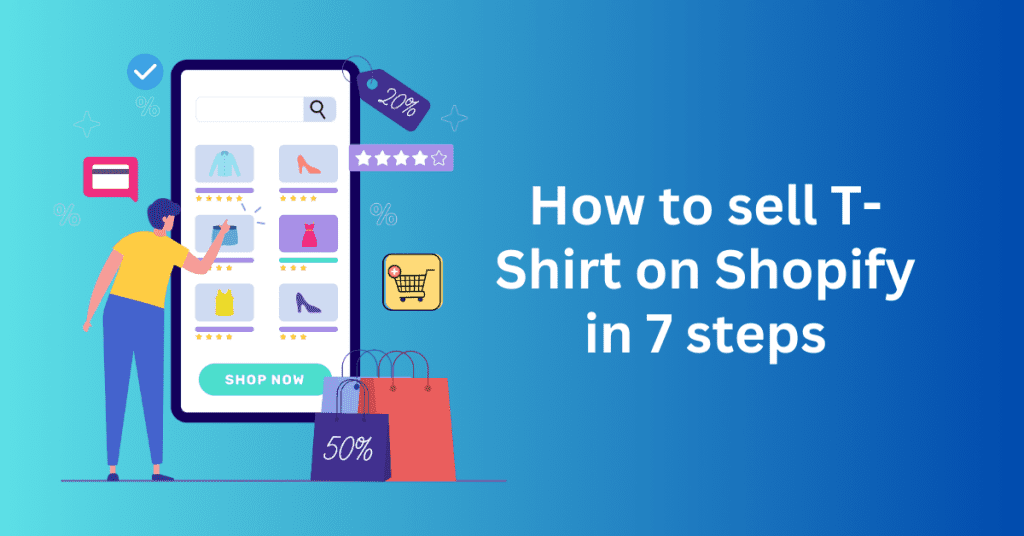
Shopify is an easy-to-use ecommerce platform where you can create a custom online store and sell your products.
What’s great about the platform is that you don’t need high upfront investments or advanced technical skills to get started.
Also, Shopify allows you to connect your store with other apps to maximise your business. For example, you can team up with a print-on-demand supplier.
Now that you know why Shopify is a handy choice for online t-shirt business owners, let’s dive into how to sell t-shirts on Shopify and stand out in this highly competitive market.
Step 1. Define Your Target Audience and Niche
To succeed in your Shopify T-shirt business, you need to ensure a solid foundation by defining your target audience and specifying your product niche. This strategic approach allows you to tailor your product to the preferences of your desired audience, setting you apart in a competitive market.

Begin by identifying your target audience, you may look into the demographics such as age, gender, education, profession, and income. Dive deeper to understand their needs, values, interests, and preferences. Instead of relying on guesswork, proactively engage with your audience through market research calls or analyze data from social media, forums, blogs, reviews, and other online sources.
The more you understand your target audience, the better you can create a product suitable for them. You may also create your customer avatar so you can visualize them better.
Then, you need to select a niche—a more specific segment within your target audience with distinct characteristics that increase the likelihood of purchasing a particular product or service. Choosing a niche enhances your potential for higher profits, reduces competition, and fosters a more loyal customer base. Ensure the chosen niche addresses a demand gap in the market. If struggling to find a niche, consider drawing inspiration from your passions, interests, or experiences.
Step 2. Create Your T-Shirt Designs
While it’s crucial to define your target audience and select a niche for your Shopify T-shirt business, these steps alone won’t guarantee success. A key element is to have a product that resonates with your audience, and this is by crafting a compelling design for your t-shirts.
Research on the Market Trend
Begin by looking into design and consumer trends, whether you’re creating the design yourself or hiring a freelancer. It’s essential to have a clear vision of your t-shirt design and logo placement if you choose to feature one. You may explore consumer and t-shirt design trends during your research, paying attention to what captivates your attention and why.
Here are some sources of inspiration:
- Social media
- Marketplace ecommerce platforms (Etsy, eBay, Amazon)
- Google Trends
- Pinterest, Behance, or Dribbble
- Art and illustrations from museums, galleries, and local exhibitions
- Nature and sightseeing
- Coffee table books and design magazines
- Motivational quotes
- Typography
- Pop culture
Additionally, you may spy on your competitor’s designs to gain insights into successful t-shirt designs and discover ways to differentiate yourself. Formulate a Unique Selling Proposition (USP) that encapsulates why customers should choose your brand over competitors. Then, address your customers’ problems and ensure your solution remains memorable, reflecting it through your design or product.
Design Your T-Shirt
Selecting an appropriate t-shirt design tool is a crucial step. T-shirt design tools provide an accessible way to initiate the design process, eliminating the need for professional design skills. Here are some recommended tools:
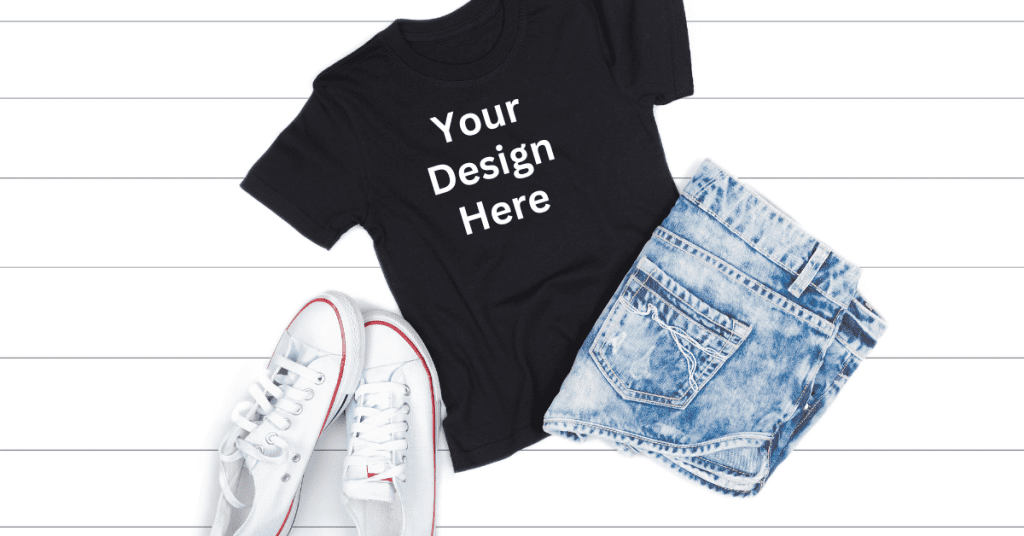
- Canva: A cloud-based graphic design tool suitable for beginners, featuring a user-friendly drag-and-drop interface, an extensive library of fonts, design assets, images, and ready-to-use templates.
- Adobe Photoshop: Recognized as an industry standard, Adobe Photoshop is known for its versatility and powerful features. While best suited for seasoned design experts, it offers advanced functionality and nearly limitless design options for bringing your t-shirt ideas to life professionally.
- Fiverr: Talented designers offer custom t-shirt designs tailored to your preferences and brand aesthetic. With a diverse pool of skilled freelancers, you can find the perfect artist to bring your unique vision to life at an affordable price.
Step 3. Decide on Your T-Shirt Manufacturing Technique for Your Shopify Store
Now, it’s time to determine your approach to customization. This crucial step connects your conceptualization stage with the actual creation of your product. When evaluating various customization methods, consider factors such as your design, the characteristics of your t-shirts, your budget constraints, and your business requirements.
Direct-to-Garment Printing (DTG):
Let’s start with one of the most popular t-shirt printing techniques—DTG, or direct-to-garment printing. This method closely resembles printing on paper, but with fabric replacing the traditional medium. During this process, a DTG printer sprays specialized water-based inks directly onto the t-shirt, achieving the desired design within minutes.
If you opt to manage this process independently, note that this digital equipment demands a substantial initial investment. Here are the method’s pros and cons:
Pros:
- Ideal for small businesses and one-off prints
- Ensures long-lasting prints
- High-quality results for intricate designs
- Soft to the touch
- Suitable for cotton and cotton blends
- No colour limitations (particularly effective for brighter colours)
Cons:
- Expensive equipment
- Requires special care for longevity
- Less cost-effective for bulk orders
- Not recommended for synthetic fabrics
Direct-to-Film Printing (DTF):
Next on the list is DTF printing, or direct-to-film printing. This is renowned for its versatility across various fabric types. This method involves printing a design on a PET film with water-based inks, utilizing a powder to facilitate the design transfer onto the t-shirt through a heat press machine. Due to the specifics of the process, investment in equipment and materials is necessary.
Here are the pros and cons:
Pros:
- Detailed prints
- Wide color palette
- Works on different fabric types
- Ideal for bulk orders
Cons:
- Slower process
- High investment costs (machines and materials)
- Not environmentally sustainable (generates significant waste from films)
- Thicker prints compared to DTG
Embroidery:
Embroidery stands out as a timeless, high-quality option for achieving a durable finish on custom t-shirts. Its texture adds a 3D effect, making it suitable for intricate designs, logos, or monograms. To create an embroidered design, digitization of the design is necessary, converting it into a digital file for the machine to execute. The machine then stitches the embroidered design, replicating the digitized file’s patterns, shapes, and colours.
Pros:
- Good durability
- Professional finishing touch
- Cost-effective for multi-colour designs
Cons:
- Not ideal for complex designs with drastic color changes
- Not recommended for small colour elements
- Less suitable for most synthetic materials (works best for cotton-polyester blends)
Sublimation:
Lastly, sublimation, also known as dye or digital sublimation, is a popular method for t-shirt designs, especially for all-over print shirts. Sublimation involves the transition of a liquid dye from a solid to a gaseous state under high temperatures and pressure. The design is initially printed onto special transfer paper, and heat is applied to allow the liquid dye to penetrate the fabric.
Here are the pros and cons:
Pros:
- More vibrant designs with vivid colours
- Durable prints that withstand numerous washes
- Perfect for all-over print t-shirts
- Smooth texture of the prints
Cons:
- Slower process
- Increased preparation may impact the overall cost
- Requires more advanced knowledge
- Not the most cost-effective for bulk orders
Step 4. Choose A T-shirt Type To Sell on Your Shopify Store
Crafting your design is just one aspect of the task. However, the other crucial step is sourcing high-quality t-shirts for printing. While it might seem that all t-shirts are alike, the choice of the right t-shirt significantly impacts your online business in the long run.
When selecting your custom t-shirt, pay close attention to its fabric, weight, and fit. The fabric, be it cotton, polyester, or a blend, influences the overall look, feel, and fit of your t-shirt. Cotton offers softness and durability but may be prone to shrinking and fading. Polyester maintains size and colour over time but is less breathable. Blended materials offer benefits from both but often require more delicate care.
Besides, consider the fabric weight based on its thickness, with lighter options being thin, soft, and breathable, midweight providing comfort across temperatures, and heavyweight ideal for cooler conditions and layering. Depending on customer preferences, you can offer one or all three options.
When it comes to fit, choose from slim, regular, or relaxed options based on your customers’ needs. Slim-fit provides a more form-fitting style, relaxed fits offer a wider but not baggy chest and waist area, and regular fit, a classic choice suitable for various body types, hugs the body while leaving room in the sleeves and waist.
Step 5. Choose A Print-On-Demand Supplier
Now, after you have decided on your products to sell, it’s time to look for a supplier. Getting a trusted supplier is important to avoid the hassle of taking care of customer complaints due to bad-quality products.
Also, in many cases, you can rely on a print-on-demand supplier to handle the inventory, process the order and ship it out for you. Both Printify and Printful emerge as one of the top print-on-demand suppliers that offers quality products.
However, the main difference between these two giants is:
Printful operates on a print-on-demand model, where products are printed and fulfilled in-house as orders come in. There are different printing facilities available worldwide to ensure your products are sent from the nearest location.
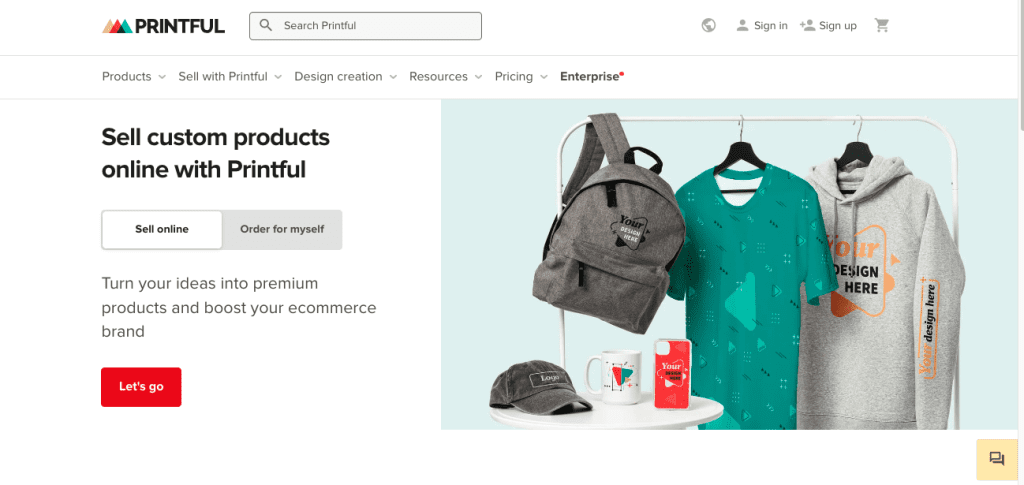
On the other hand, Printify operates as a print-on-demand marketplace that connects sellers with a network of printing partners. Printify allows you to choose from a variety of printing partners based on factors such as location, pricing, and product offerings. You will have the flexibility to select different printing providers for different products, enabling you to optimize costs and quality.
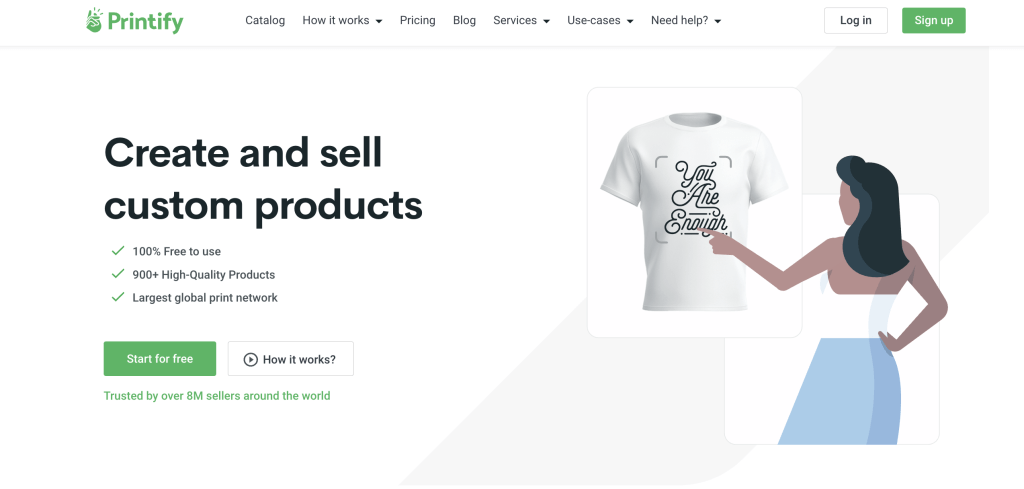
And of course, both Printify and Printful offer seamless integration to the Shopify store. All you need is to install their respective app on your Shopify store and follow the guide for integration.
Step 6. Design and Optimize Your T-Shirt Shopify Store
One popular method is integrating your custom t-shirts directly through the Shopify admin panel. However, if you’ve partnered with a reliable print-on-demand service like Printify or Printful, you can seamlessly connect your Shopify store with your POD account. Many online t-shirt business owners opt for Shopify due to its user-friendly platform, making it easy to set up, use, and customize for the perfect store aesthetic.
To begin, create a Shopify account and choose a plan that aligns with your business needs and budget. You may opt for the basic plan and upgrade later when your business grows.

Then, follow the guide to select your domain and store name, and pick a Shopify theme from the variety of pre-made templates available. There are both free and paid themes for you to choose from. Don’t go for the default one as most new sellers will use that. Your store will look very similar to others.
Customizing your store is a breeze with Shopify themes. It allows you to adjust layout, colours, and fonts to perfectly mirror your brand and niche. Besides, consider elements you want to emphasize, such as your brand story, vibrant colours, product focus, or intricate details like typography. Then, unleash your creativity while ensuring a user-friendly website.
Now, populate your catalogue with your t-shirts using one of two methods. If partnered with a print-on-demand service like Printify, integrate your store seamlessly. During the product addition process, pay extra attention to image quality and detailed product descriptions to optimize their impact.
Step 7. Marketing For Your T-Shirt Shopify Store
After you have built the basics of your business, created a compelling design, and crafted a product you’re proud of, it’s time to promote your online t-shirt business and market your product effectively.
Product Marketing Strategy
A step-by-step plan designed to reach your target audience and convert them into loyal customers. This strategy enhances clarity in communicating your vision and promoting your product, expediting the achievement of your goals. You may base your strategy on four pillars: customer analysis, competitor research, your Unique Selling Proposition (USP), and realistic goal-setting.
Shopify Store SEO
Then, you need to optimize your store to enhance the visitor’s shopping experience, even if you’re content with its current appearance. Implementing tweaks such as adding alternative text for images to boost SEO, incorporating an order confirmation email in the purchase flow, and integrating videos into your product catalogue can significantly improve store performance, attract more visitors, and increase revenue.
Social Media Marketing
Leverage the power of social media marketing in 2024, as it remains one of the most cost-efficient ways to showcase your brand, build a community, and generate sales. With 4.9 billion global social media users, tapping into platforms like Facebook, YouTube, Instagram, TikTok, Twitter, and LinkedIn allows you to reach your target audience effectively. You can tailor your content for each platform based on the latest trends, and consider utilizing influencer marketing to boost brand discoverability and sales by partnering with influential spokespersons.
Email Marketing
In contrast to social media, email marketing may involve a minimal initial investment for lead generation and autoresponder software. Unlike social media accounts that can be unexpectedly shut down, email marketing provides a reliable means to consistently communicate with your audience.
You can create a landing page and promote that on your Shopify store contact form or social media. Then, promote your newsletter through social media, utilize customer contact details from previous purchases, or integrate a subscription form on your website to gather email addresses.
By sending send newsletters regularly to update, inspire, educate, and cultivate a connection with your email subscribers, you can nurture your past customers to be recurring customers. Then, leverage this channel to disseminate information about special campaigns such as new product launches, website sales, holiday discounts, and more.
Website Marketing
Your website often serves as a potential customer’s first interaction with your brand. Hence, the appearance and user experience is very important. Before launching your website, you may get some feedback on the user experience from your friends or family to understand how first-time visitors feel about your website.
Besides, you can enhance your website by incorporating user-generated content, such as customer reviews and testimonials, to instil trust in potential buyers. Finally, ensure your website is SEO-friendly by incorporating relevant keywords into product names, descriptions, and web copy. SEO, or search engine optimization, enhances the visibility of your products on search engines, making them more likely to reach a broader audience.
Final Thoughts: How to Sell T-Shirt on Shopify
Starting a T-shirt store on Shopify is a lucrative business. You don’t need to have too many designs, but just one winning design can scale your business big.
With print-on-demand, you don’t need to print all the products out and keep a huge inventory. Hence, the investment required to start is very small and you can test multiple fast.
Follow the steps explained, then you will be able to start and launch your Shopify T-Shirt Store today.




